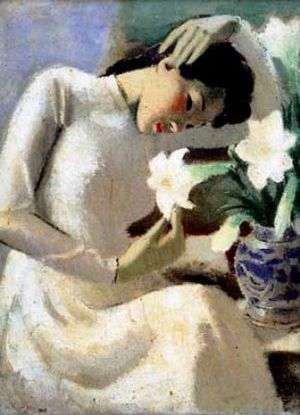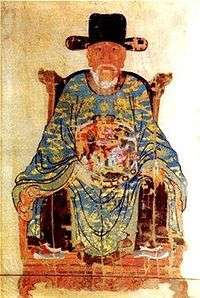Vietnamese art
Vietnamese art is visual art that, whether ancient or modern, originated in or is practiced in Vietnam or by Vietnamese artists.
Introduction
Vietnamese art has a long and rich history, the earliest examples of which date back as far as the Stone Age around 8,000 BCE.
With the millennium of Chinese domination starting in the 2nd century BC, Vietnamese art undoubtedly absorbed many Chinese influences, which would continue even following independence from China in the 10th century AD. However, Vietnamese art has always retained many distinctively Vietnamese characteristics.
By the 19th century, the influence of French art took hold in Vietnam, having a large hand in the birth of modern Vietnamese art.
Vietnamese art throughout the ages
Neolithic art
Pottery dating to the Stone Age (c. 8000 BCE) has been found in Bac Son, Vietnam. This pottery was made from clay, and in its beginnings was largely basic and lacking any artistic flare. Moving into the neolithic era, however, Vietnamese pottery and ceramics started to develop rapidly, showing signs of decor.
Bronze Age art
The highly developed Đông Sơn culture that flourished in North Vietnam (from about 1000 BC to the 4th century BC) was the civilization responsible for the world-famous Đông Sơn drums, a product of their advanced bronze-casting skills.
These drums give us an important peek into early Vietnamese life. They were elaborately decorated with geometric patterns, and most importantly, depicted scenes of everyday life such as farming, warriors donning feather headdresses, construction of ships, musicians, etc.
Archaeological evidence from this period also shows that people in the area had long been weaving cloth. Many of the people depicted on the drums are shown as wearing elaborate clothing.
Chinese domination from 111 BC to 939 AD
During the ten centuries of rule by the Chinese, Vietnamese began to apply newly learned Chinese techniques to art and specifically ceramics, however this was in conjunction with the continued production of art based on native methods; this is proven by excavation of Chinese tombs in the area.[1]
From the Ngô to Trần Dynasty
Vietnamese art and ceramics during this period of independence (approximately 10th to 15th centuries) flourished. The ceramics from this period were thought to have been largely influenced by both ancient native styles and the Tang and later Song Dynasty's art, including applying the "three colors" concept to its ceramics. Chinese-influenced philosophies adopted by the Vietnamese such as Confucianism, Mahayana Buddhism and Taoism all had a lasting impression on Vietnamese art. Some also claim there are small traces of Cham influences to be found as well.
The Lý Dynasty, beginning in the 11th century is viewed specifically as the golden age of Vietnamese art, and its ceramics became famous across East and Southeast Asia. The Lý Dynasty also saw the construction of many of Vietnam's landmark structures, including the Temple of Literature, One-pillar pagoda, and Quynh Lam pagoda. The Trần Dynasty that immediately followed in the 13th century saw a more subdued approach to art.[2]
Fourth Chinese domination and Lê Dynasty
The fourth Chinese domination of Vietnam was quite short-lived, lasting only about 2 decades, yet it was also seen as the harshest domination. Many if not most classical Vietnamese books were burnt, and thus much documentation of the era of independence lost. It is said that a more extreme than-ever process of sinicization was enforced, and countless Vietnamese resources and goods were removed and taken to China.
Consequently, much of the art in this period and even after liberation by the Lê Dynasty was heavily influenced by the Ming Dynasty's art.
Nguyễn Dynasty
The Nguyễn Dynasty, the last ruling dynasty of Vietnam, saw a renewed interest in ceramics and porcelain art. Imperial courts across Asia imported Vietnamese ceramics.
Despite how highly developed the performing arts (such as imperial court music and dance) became during the Nguyễn Dynasty, some view other fields of arts as beginning to decline during the latter part of the Nguyễn Dynasty.
Modern art

Beginning in the 19th century, French artistic influences spread into Vietnam. In the early 20th century, the École Supérieure des Beaux Arts de l’Indochine (Indochina College of Arts) was founded to teach European methods and exercised influence mostly in the larger cities, such as Hanoi and Saigon.[3]
Travel restrictions imposed on the Vietnamese during France's 80-year rule of Vietnam and the long period of war for national independence meant that very few Vietnamese artists were able to train or work outside of Vietnam.[4] A small number of artists from well-to-do backgrounds had the opportunity to go to France and make their careers there for the most part.[4] Examples include Le Thi Luu, Le Pho, Mai Trung Thu, Le Van De, Le Ba Dang and Pham Tang.[4]
Modern Vietnamese artists began to utilize French techniques with many traditional mediums such as silk, lacquer, etc., thus creating a unique blend of eastern and western elements. .
Contemporary Art
Nowadays, besides working with traditional material like oil, acrylic, lacquer on wood, the younger generation of Vietnamese artists have become very active in involving different forms of arts, such as installation, performance and video art with many of them attaining international recognition for their artworks and exhibitions worldwide.[5] For example, Nha San Collective (formerly Nha San Studio) - established in 1998, was the first artist-led, non-profit initiative to be run in Vietnam.[6] Nha San studio nurtured the first generation of Vietnamese avant-garde artists emergent in the early 1990s [7]
Cinema
Architecture
It is believed that in prehistoric times, Vietnamese people lived in stilt-houses, as depicted on the bronze Dong Son drums. Similar kinds of houses can still be found in Vietnam today.
When Chinese influence permeated Vietnam, Chinese architecture had a large influence on the basic structure of many types of Vietnamese buildings, mostly pagodas and temples, communal houses, houses of scholar-bureaucrats, aristocracy, and imperial palaces and quarters. Nevertheless, these structures combined both Chinese influences and native style. With French colonization of Vietnam in the 19th century, many French-styled buildings were constructed, including villas, government buildings, opera houses, etc. Many of these buildings still stand in Vietnam and are one of the clearest remnants of the French colonial legacy.
Some of Vietnam's most notable architectural structures include:
- The Temple of Literature or (Văn Miếu): Located in Hanoi, North Vietnam. It was constructed during the Lý Dynasty and dedicated to Confucius and his disciples. It is a fine example of the elegance of Lý Dynasty architecture, although much if it is in need of repair. The Temple of Literature is a series of courtyards, buildings and pavilions, the center of which houses the famed stone steles. These steles are placed on top of stone turtles, and are inscribed with the names of doctorate candidates successful at the Imperial examination. Also within the temple lies the "Quốc Tử Giám" or National University, which functioned for approximately 700 years, from 1076 to 1779.
- Imperial City, Huế: During the reign of the Nguyễn Dynasty, a new imperial citadel in Huế was built, largely based on the Chinese Forbidden City in Beijing, and also called the Purple forbidden city. However, it still employed many obviously Vietnamese characteristics in its design. Other imperial structures built much later, such as the outlying tomb of Khải Định, used French architectural elements as well. The tomb of Minh Mạng is often considered one of the most beautiful structures in the Huế area, situated near a vast lotus pond, its construction was not completed until after Minh Mạng's death.
The citadel formerly sprawled a vast estate, but during subsequent wars and conflicts, much of it has been destroyed and later turned into rice paddies. The remaining areas are currently being restored by UNESCO.
- One Pillar Pagoda: The one pillar pagoda is one of the most ancient structures of Hanoi, its design credited to Emperor Lý Thái Tổ. The story goes that the emperor had longed for a son, and one day dreamed that the Goddess of Mercy was sitting on a lotus flower offering him a son. In grattitude and reverence of his dream he ordered construction of a small pagoda in the form of a lotus, overlooking a pond. The pagoda has been rebuilt countlessly due to it being destroyed and burnt in wars by opponents.
- Perfume Pagoda and the surrounding area: The Perfume pagoda is an ancient structure in Ha Tay province, located specifically in Perfume mountain, and is the site for a yearly festival attended by hundreds of thousands of Vietnamese. Most people reach the pagoda by taking an hour boat ride across the scenic river (passing the countryside scattered with smaller pagodas) before reaching the Perfume Pagoda itself. Inside are a series of temples and structures, and a grotto with stairs leading to two paths: "Heaven's gate" and "Hell's gate". Descending deep into the grotto one finds the Inner temple.
The beauty of the Perfume Pagoda and surrounding area have served as the subject in many Vietnamese poems.
Calligraphy
Calligraphy has had a long history in Vietnam, previously using Chinese characters along with chữ nôm. However, most modern Vietnamese calligraphy instead uses the Roman-character based quốc ngữ, which has proven to be very popular.
In the past, with literacy in the old character-based writing systems of Vietnam being restricted to scholars and elites, calligraphy nevertheless still played an important part in Vietnamese life. On special occasions such as the Lunar New Year, people would go to the village teacher or scholar to make them a calligraphy hanging (often poetry, folk sayings or even single words). People who could not read or write also often commissioned scholars to write prayers which they would burn at temple shrines.
Visual arts
Silk painting

Vietnamese silk painting is one of the most popular forms of art in Vietnam, favored for the mystical atmosphere that can be achieved with the medium. During the 19th and 20th centuries, French influence was absorbed into Vietnamese art and the liberal and modern use of color especially began to differentiate Vietnamese silk paintings from their Chinese, Japanese and Korean counterparts.[8] Vietnamese silk paintings typically showcase the countryside, landscapes, pagodas, historical events or scenes of daily life.
Woodblock prints

A folk art with a long history in Vietnam, Vietnamese woodblock prints have reached a level of popularity outside of Vietnam.[9] Organic materials are used to make the paint, which is applied to wood and pressed on paper. The process is repeated with different colors.
Performing arts
Traditional music
Traditional Vietnamese music is extremely diverse, consisting of many different styles varying from region to region. Some of the most widely known genres include:
- Quan họ: A type of improvisational music, it is sung a cappella and has a longstanding tradition in Vietnam, used in courtship rituals.
- Imperial Court music: Music performed in the Vietnamese court during feudalistic times. When referring specifically to the "Nhã nhạc" form it includes court music from the Trần Dynasty on to the Nguyễn Dynasty. It features an array of instruments, featuring musicians and dancers adorned in elaborate garb.
- Ca trù: An ancient form of chamber music which originated in the imperial court. It gradually came to be associated with a geisha-type of entertainment where talented female musicians entertained rich and powerful men, often scholars and bureaucrats who most enjoyed the genre. It was condemned in the 20th century by the government, being tied falsely with prostitution, but recently it has seen a revival as appreciation for its cultural significance has grown. Vietnam has completed documents to have Ca tru recognized by UNESCO as a potential Intangible Cultural Heritage.
Traditional theatre
.jpg)
Genres include:
- Cải lương: A kind of modern folk opera originating in South Vietnam, which utilizes extensive vibrato techniques. It remains very popular in modern Vietnam when compared to other folk styles.
- Hát chèo: The most mainstream of theatre/music forms in the past, enjoyed widely by the public rather than the more obscure Ca trù which was favored more by scholars and elites.
- Hát tuồng (also known as Hát bội): A theatre form strongly influenced by Chinese opera, it transitioned from being entertainment for the royal court to travelling troupes who performed for commoners and peasants, featuring many well-known stock characters.
Traditional dance
Vietnam has 54 different ethnics, each with their own traditional dance. Among the ethnic Vietnamese majority, there are several traditional dances performed widely at festivals and other special occasions, such as the lion dance.
In the imperial court there also developed throughout the centuries a series of complex court dances which require great skill. Some of the more widely known are the imperial lantern dance, fan dance, and platter dance, among others.
Water puppetry
Water puppetry is a distinct Vietnamese art which had its origins in the 12th century. In water puppetry, a split-bamboo screen obscures puppets which stand in water and are manipulated using long poles hidden beneath the water. Epic storylines are played out with many different characters, often depicting traditional scenes of Vietnamese life. Despite nearly dying out in the 20th century, it has been saved by efforts of preservation and is now largely seen by tourists to Vietnam.
Language arts
Literature
Vietnamese literature is literature, both oral and written, created largely by Vietnamese-speaking people, although Francophone Vietnamese and English-speaking Vietnamese authors in Australia and the United States are counted by many critics as part of the national tradition. For much of its history, Vietnam was dominated by China and as a result much of the written work during this period was in Classical Chinese. Chữ nôm, created around the 10th century, allowed writers to compose in Vietnamese using modified Chinese characters. Although regarded as inferior to Chinese, it gradually grew in prestige. It flourished in the 18th century when many notable Vietnamese writers and poets composed their works in chữ nôm and when it briefly became the official written script. While the quốc ngữ script was created in the 17th century, it did not become popular outside of missionary groups until the early 20th century, when the French colonial administration mandated its use in French Indochina. By the mid-20th century, virtually all Vietnamese works of literature were composed in quốc ngữ.
Some defining works of literature include The Tale of Kieu by Nguyễn Du, and Lục Vân Tiên by Nguyễn Đình Chiểu.
Poetry
Poet Hồ Xuân Hương (born during the end of the 18th century) composed much of her poetry in Chữ Nôm, and most of it has been translated into quốc ngữ for modern Vietnamese. Her poetry continues to be widely popular. Other poets such as the famous Mandarin official Duong Khue had some of his poetry adapted into songs that are still famous today, such as the Ca trù-genre song "Hồng hồng, tuyết tuyết".
Many Vietnamese poems, along with folk "literature" in general, tends to be much more of an oral tradition - as literacy (as it is defined today) in the past was restricted mostly to scholars and the elite.
See also
Notes
- ↑ http://www.vietnamartbooks.com/articles/article.html?id=67 Pottery and ceramics during Chinese rule
- ↑ VietNamNet Bridge
- ↑ Art History - A Brief History Of Vietnam Fine Art
- 1 2 3 Ngoc, Huu (2000). "Modern Painting: Tracing the Roots". Vietnam Cultural Window. Thế Giới Publishers. 29. Retrieved 2010-04-23. Full text available here
- ↑ http://hyperallergic.com/181080/in-vietnam-contemplating-the-future-of-contemporary-art/
- ↑ http://theculturetrip.com/asia/vietnam/articles/the-most-influential-contemporary-art-spaces-in-vietnam/
- ↑ http://www.lasalle.edu.sg/trending-stories/in-conversation-with-jeffrey-say/
- ↑ Art of Vietnam
- ↑ Forbes, Andrew, and Henley, David: Vietnam Past and Present: The North (History and culture of Hanoi and Tonkin). Chiang Mai. Cognoscenti Books, 2012. ASIN: B006DCCM9Q.
Further reading
- Lerner, Martin (1984). The flame and the lotus: Indian and Southeast Asian art from the Kronos collections. New York: The Metropolitan Museum of Art. ISBN 0870993747.
External links
| Wikimedia Commons has media related to Art of Vietnam. |
- Viettouch. This site is dedicated to the promotion of Vietnamese history and culture; see reviews of the site.
- Dong Son bronze drums (Photo collection)
- Vietnamese blockwood prints
- History of Vietnam including Dong Son civilization
- Brief history of Vietnamese ceramics and pottery
- Brief with links on Vietnamese Art History
- Arts of Ancient Vietnam, Asia Society Exhibition, Feb. 2 - May 2, 2010
